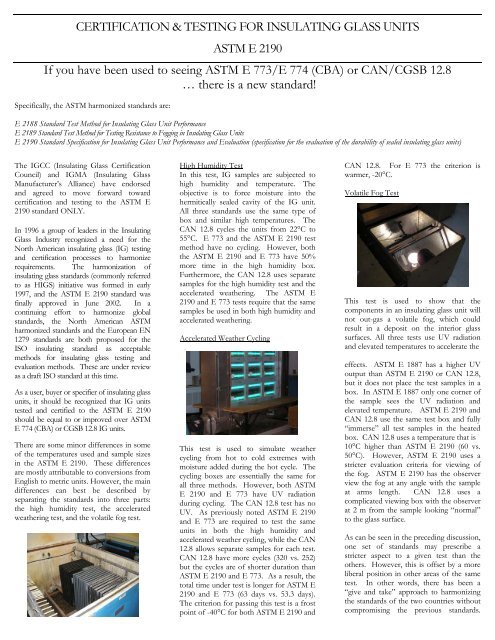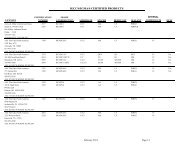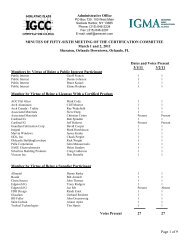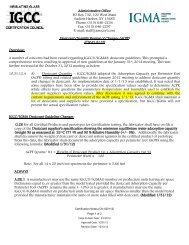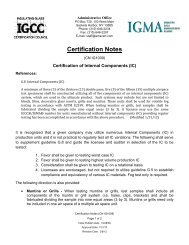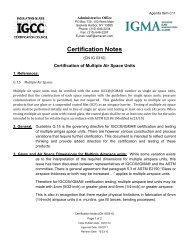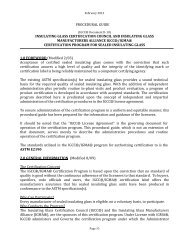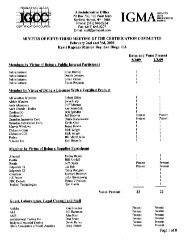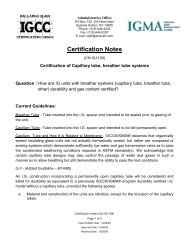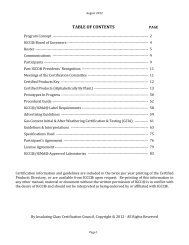ASTM E 2190 US-Canada Comparison Education Piece
ASTM E 2190 US-Canada Comparison Education Piece
ASTM E 2190 US-Canada Comparison Education Piece
Create successful ePaper yourself
Turn your PDF publications into a flip-book with our unique Google optimized e-Paper software.
CERTIFICATION & TESTING FOR INSULATING GLASS UNITS<br />
<strong>ASTM</strong> E <strong>2190</strong><br />
If you have been used to seeing <strong>ASTM</strong> E 773/E 774 (CBA) or CAN/CGSB 12.8<br />
… there is a new standard!<br />
Specifically, the <strong>ASTM</strong> harmonized standards are:<br />
E 2188 Standard Test Method for Insulating Glass Unit Performance<br />
E 2189 Standard Test Method for Testing Resistance to Fogging in Insulating Glass Units<br />
E <strong>2190</strong> Standard Specification for Insulating Glass Unit Performance and Evaluation (specification for the evaluation of the durability of sealed insulating glass units)<br />
The IGCC (Insulating Glass Certification<br />
Council) and IGMA (Insulating Glass<br />
Manufacturer’s Alliance) have endorsed<br />
and agreed to move forward toward<br />
certification and testing to the <strong>ASTM</strong> E<br />
<strong>2190</strong> standard ONLY.<br />
In 1996 a group of leaders in the Insulating<br />
Glass Industry recognized a need for the<br />
North American insulating glass (IG) testing<br />
and certification processes to harmonize<br />
requirements. The harmonization of<br />
insulating glass standards (commonly referred<br />
to as HIGS) initiative was formed in early<br />
1997, and the <strong>ASTM</strong> E <strong>2190</strong> standard was<br />
finally approved in June 2002. In a<br />
continuing effort to harmonize global<br />
standards, the North American <strong>ASTM</strong><br />
harmonized standards and the European EN<br />
1279 standards are both proposed for the<br />
ISO insulating standard as acceptable<br />
methods for insulating glass testing and<br />
evaluation methods. These are under review<br />
as a draft ISO standard at this time.<br />
As a user, buyer or specifier of insulating glass<br />
units, it should be recognized that IG units<br />
tested and certified to the <strong>ASTM</strong> E <strong>2190</strong><br />
should be equal to or improved over <strong>ASTM</strong><br />
E 774 (CBA) or CGSB 12.8 IG units.<br />
There are some minor differences in some<br />
of the temperatures used and sample sizes<br />
in the <strong>ASTM</strong> E <strong>2190</strong>. These differences<br />
are mostly attributable to conversions from<br />
English to metric units. However, the main<br />
differences can best be described by<br />
separating the standards into three parts:<br />
the high humidity test, the accelerated<br />
weathering test, and the volatile fog test.<br />
High Humidity Test<br />
In this test, IG samples are subjected to<br />
high humidity and temperature. The<br />
objective is to force moisture into the<br />
hermitically sealed cavity of the IG unit.<br />
All three standards use the same type of<br />
box and similar high temperatures. The<br />
CAN 12.8 cycles the units from 22°C to<br />
55°C. E 773 and the <strong>ASTM</strong> E <strong>2190</strong> test<br />
method have no cycling. However, both<br />
the <strong>ASTM</strong> E <strong>2190</strong> and E 773 have 50%<br />
more time in the high humidity box.<br />
Furthermore, the CAN 12.8 uses separate<br />
samples for the high humidity test and the<br />
accelerated weathering. The <strong>ASTM</strong> E<br />
<strong>2190</strong> and E 773 tests require that the same<br />
samples be used in both high humidity and<br />
accelerated weathering.<br />
Accelerated Weather Cycling<br />
This test is used to simulate weather<br />
cycling from hot to cold extremes with<br />
moisture added during the hot cycle. The<br />
cycling boxes are essentially the same for<br />
all three methods. However, both <strong>ASTM</strong><br />
E <strong>2190</strong> and E 773 have UV radiation<br />
during cycling. The CAN 12.8 test has no<br />
UV. As previously noted <strong>ASTM</strong> E <strong>2190</strong><br />
and E 773 are required to test the same<br />
units in both the high humidity and<br />
accelerated weather cycling, while the CAN<br />
12.8 allows separate samples for each test.<br />
CAN 12.8 have more cycles (320 vs. 252)<br />
but the cycles are of shorter duration than<br />
<strong>ASTM</strong> E <strong>2190</strong> and E 773. As a result, the<br />
total time under test is longer for <strong>ASTM</strong> E<br />
<strong>2190</strong> and E 773 (63 days vs. 53.3 days).<br />
The criterion for passing this test is a frost<br />
point of -40°C for both <strong>ASTM</strong> E <strong>2190</strong> and<br />
CAN 12.8. For E 773 the criterion is<br />
warmer, -20°C.<br />
Volatile Fog Test<br />
This test is used to show that the<br />
components in an insulating glass unit will<br />
not out-gas a volatile fog, which could<br />
result in a deposit on the interior glass<br />
surfaces. All three tests use UV radiation<br />
and elevated temperatures to accelerate the<br />
effects. <strong>ASTM</strong> E 1887 has a higher UV<br />
output than <strong>ASTM</strong> E <strong>2190</strong> or CAN 12.8,<br />
but it does not place the test samples in a<br />
box. In <strong>ASTM</strong> E 1887 only one corner of<br />
the sample sees the UV radiation and<br />
elevated temperature. <strong>ASTM</strong> E <strong>2190</strong> and<br />
CAN 12.8 use the same test box and fully<br />
“immerse” all test samples in the heated<br />
box. CAN 12.8 uses a temperature that is<br />
10°C higher than <strong>ASTM</strong> E <strong>2190</strong> (60 vs.<br />
50°C). However, <strong>ASTM</strong> E <strong>2190</strong> uses a<br />
stricter evaluation criteria for viewing of<br />
the fog. <strong>ASTM</strong> E <strong>2190</strong> has the observer<br />
view the fog at any angle with the sample<br />
at arms length. CAN 12.8 uses a<br />
complicated viewing box with the observer<br />
at 2 m from the sample looking “normal”<br />
to the glass surface.<br />
As can be seen in the preceding discussion,<br />
one set of standards may prescribe a<br />
stricter aspect to a given test than the<br />
others. However, this is offset by a more<br />
liberal position in other areas of the same<br />
test. In other words, there has been a<br />
“give and take” approach to harmonizing<br />
the standards of the two countries without<br />
compromising the previous standards.
Harmonized IG Standards <strong>Comparison</strong><br />
Temp. (Deg. F)<br />
160<br />
140<br />
120<br />
100<br />
<strong>ASTM</strong> E E 2188 / / E E <strong>2190</strong> (HIGS) Weather Cycle Test<br />
80<br />
73<br />
0<br />
33<br />
6 6<br />
60<br />
0 1 2 33 44 5 5 6 6<br />
40<br />
20<br />
0<br />
-20<br />
-40<br />
Accelerated Weather Test – Schematic Drawings<br />
According to<br />
<strong>ASTM</strong> E 2188/ E 2189 and <strong>ASTM</strong> E 773/E 774<br />
1 2<br />
Time (Hours)<br />
44 55<br />
<strong>ASTM</strong> <strong>ASTM</strong> E 2188 E 2188<br />
Ultraviolet<br />
Light Light<br />
Exposure<br />
Fog Fog or or Mist Mist<br />
Spray Spray<br />
Expose Six Six IGU IGU<br />
Specimens for for 252 252 Cycles<br />
Cycles (63 Days). (63 Days). Each Each cycle: 6 h<br />
cycle: + 5 6 min. h + 5 min.<br />
Final Final Dew Dew Point Point Shall Shall be be - -<br />
40 40 deg deg F or F or colder.<br />
<strong>US</strong> Standards Canadian Standards HIGS<br />
<strong>ASTM</strong> E 773, E 1887, E 774 CAN 12.8<br />
<strong>ASTM</strong> E 2188, E 2189, E<br />
<strong>2190</strong><br />
High Humidity Test<br />
Max temp. 60+/- 3 C 55+/- 3 C 60+/- 3 C<br />
Min. temp. (constant temperature) 22+/- 3 C (constant temperature)<br />
%RH 95% +/-5% constant water mist 95% +/-5%<br />
total time 42 days* 28 days**<br />
42 days (14 days + 28<br />
days)*<br />
Accel. Weather Cycle test<br />
high temp 57+/-3 C 50+/-3 C 60+/- 3 C<br />
low temp -30+/-3 C -32+/-3 C -29+/-3 C<br />
UV source F72T12BL/HO none F72T12BL/HO<br />
UV output 10 W/m 2 n/a 10 W/m 2<br />
moisture 30 min. spray 5 min. spray 30 min. spray<br />
time per cycle 6 hr. 4 hr. 6 hr.<br />
# of cycles 252 320 252<br />
total time 63 days 53.3 days 63 days<br />
Temp. (Deg. F)<br />
<strong>ASTM</strong> E 773 / E 774 Weather Cycle Test<br />
160<br />
140<br />
120<br />
100<br />
7<br />
80<br />
60<br />
0 1 2 3 4 5 6<br />
40<br />
20<br />
0<br />
-20<br />
-40<br />
Time (Hours)<br />
<strong>ASTM</strong> E 773<br />
Ultraviolet<br />
Light<br />
Exposure<br />
Water Spray<br />
Expose Six IGU Specimens for<br />
Prescribed No. of Cycles:<br />
Each cycle: 6 h + 5 min.<br />
Class C: 140 Cycles - Final Dew Point<br />
-30 deg. F or colder.<br />
Class B: Additional 56 Cycles - Final<br />
Dew Point -20 deg. F or colder<br />
Class A: Additional 56 Cycles - Final<br />
Dew Point -20 deg. F or colder.<br />
Total Duration (C, B & A): 63 Days<br />
Insulating Glass Manufacturers Alliance<br />
1500 Bank Street<br />
Ottawa, ON K1H 1B8<br />
Telephone: (613) 233-1510<br />
Fax: (613) 482-9436<br />
www.igmaonline.org<br />
Volatile Fog Test<br />
type corner UV exposure full immersion box full immersion box<br />
glass temp at corner 65 C +/- 3C(at corner only) 60 +/-3 C 50 +/-3 C<br />
glass temp other locations 24 C min. 60 +/-3 C (full immersion) 50 +/-3 C<br />
cooling plate temp 21 +/-3 C 22 +/-3 C 21 +/-3 C<br />
cooling plate area 0.016m² (127 x 127 mm) 0.018m² (150mm dia) 0.018m² (150mm dia)<br />
UV lamp Osram Ultra Vitalux 300w Osram Ultra Vitalux 300w Osram Ultra Vitalux 300w<br />
lamp output<br />
2.0 mW/cm² @ glass surface<br />
[2000μW/cm2]<br />
For further information please contact<br />
0.4 mW/cm 2 @ 300 nm<br />
[400 μW/cm2] 400 μW/cm 2 @ 355 nm<br />
Evaluation criteria<br />
Frost point test E546 w/ dry ice brass cup w/ dry ice &alcohol<br />
E546 w/ dry ice or<br />
CGSB 12.8 method<br />
max. frost point -29 C -40 C -40 C<br />
visible fog no fog at arms' length<br />
no fog at 2m normal to view<br />
box<br />
no fog at arms' length<br />
Additional CAN 12.8 tests:<br />
Initial Seal Test (optional)<br />
argon concentration<br />
water immersion test (argon)<br />
* Both E774 and E<strong>2190</strong> use same units in both in accelerated weathering and high humidity<br />
** CAN 12.8 uses separate samples for accelerated weathering and high humidity<br />
Insulating Glass Certification Council<br />
PO Box 730, 100 West Main St<br />
Sackets Harbor, NY 13685<br />
Telephone: (315) 6467-2234<br />
Fax: (315) 646-2297<br />
www.igcc.org


